Salesforce Bundle
Can Salesforce Maintain Its Dominance?
From a San Francisco apartment to a global tech giant, Salesforce revolutionized customer relationship management (CRM) with its cloud-based software. The company's innovative Software-as-a-Service (SaaS) model disrupted the industry, leading to impressive growth and a commanding market share. With a 21.8% market share in CRM as of 2024 and $34.9 billion in revenue, Salesforce's journey is a testament to its strategic prowess.
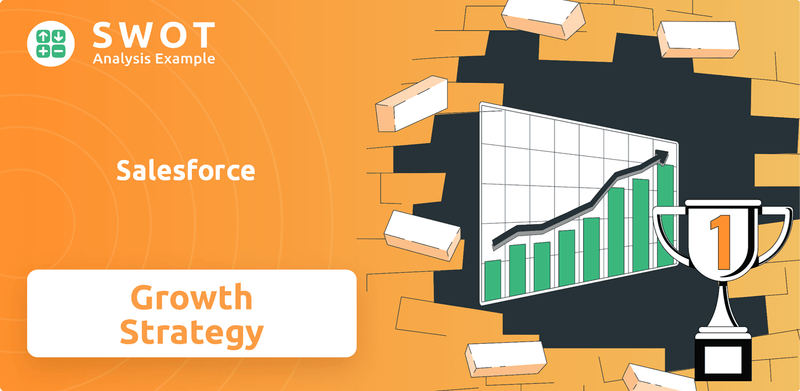
This deep dive explores the Salesforce SWOT Analysis, examining the Salesforce growth strategy and the Salesforce future prospects within the dynamic cloud computing landscape. We'll dissect Salesforce's market analysis report, including its competitive landscape, financial performance, and long-term growth potential, to provide actionable insights for investors and business strategists. Understanding Salesforce's expansion into new markets, innovation and development, and strategic partnerships is crucial for anticipating its future trajectory in the CRM software industry.
How Is Salesforce Expanding Its Reach?
The expansion initiatives of Salesforce, a leading CRM software provider, are strategically designed to foster growth and solidify its position in the market. These initiatives encompass entering new markets, launching innovative products, and forming strategic partnerships. The company's focus is on both geographical expansion and product diversification to meet evolving customer needs, which is crucial for its long-term growth potential.
Salesforce's approach to growth is multi-faceted, involving both organic expansion and strategic acquisitions. The company continually adapts its strategies to maintain its competitive edge in the dynamic cloud computing landscape. This includes a strong emphasis on artificial intelligence (AI) and data-driven solutions, which are key components of its future prospects.
Salesforce is actively pursuing international expansion, particularly in emerging markets, to diversify its revenue streams and reduce its reliance on established markets. This geographical diversification is a key component of their Salesforce growth strategy. Simultaneously, the company is developing industry-specific cloud solutions to cater to a wide range of sectors, including healthcare, edTech, and manufacturing, which is a strategic move to enhance its Salesforce market share.
Salesforce is targeting emerging markets to fuel its growth. This strategic move helps reduce the company's dependence on saturated markets. By entering new markets, Salesforce aims to capture a larger customer base and increase its overall revenue.
Salesforce is developing tailored solutions for industries like healthcare and manufacturing. These specialized clouds provide customized CRM capabilities, addressing unique industry needs. This approach allows Salesforce to penetrate diverse sectors more effectively.
Salesforce is heavily investing in AI and data-driven solutions. Agentforce, launched in September 2024, is designed to automate tasks. Salesforce is integrating AI to enhance its CRM capabilities and improve customer interactions.
The AppExchange marketplace is a key component of Salesforce's ecosystem. It offers third-party integrations to customize CRM systems. This expansion allows users to tailor their systems to specific needs.
Salesforce's product pipeline is heavily focused on AI and data solutions, with Agentforce leading the charge. The company is also enhancing existing products such as Salesforce Flow to improve user experience and functionality. Furthermore, Salesforce is strengthening collaborations with tools like Tableau and Slack for seamless data integration.
- Agentforce: Launched in September 2024, with 1,000 deals closed.
- Salesforce Flow: A low-code solution for rapid application development.
- Tableau and Slack: Enhanced data integration and collaboration capabilities.
- Salesforce Genie: A real-time data platform gaining significant traction.
Salesforce's strategic partnerships and acquisitions are vital for its expansion. By collaborating with other technology providers, Salesforce can integrate its CRM software with complementary tools and services, enhancing its overall offering. To understand how Salesforce generates revenue, check out this article: Revenue Streams & Business Model of Salesforce.
Salesforce SWOT Analysis
- Complete SWOT Breakdown
- Fully Customizable
- Editable in Excel & Word
- Professional Formatting
- Investor-Ready Format
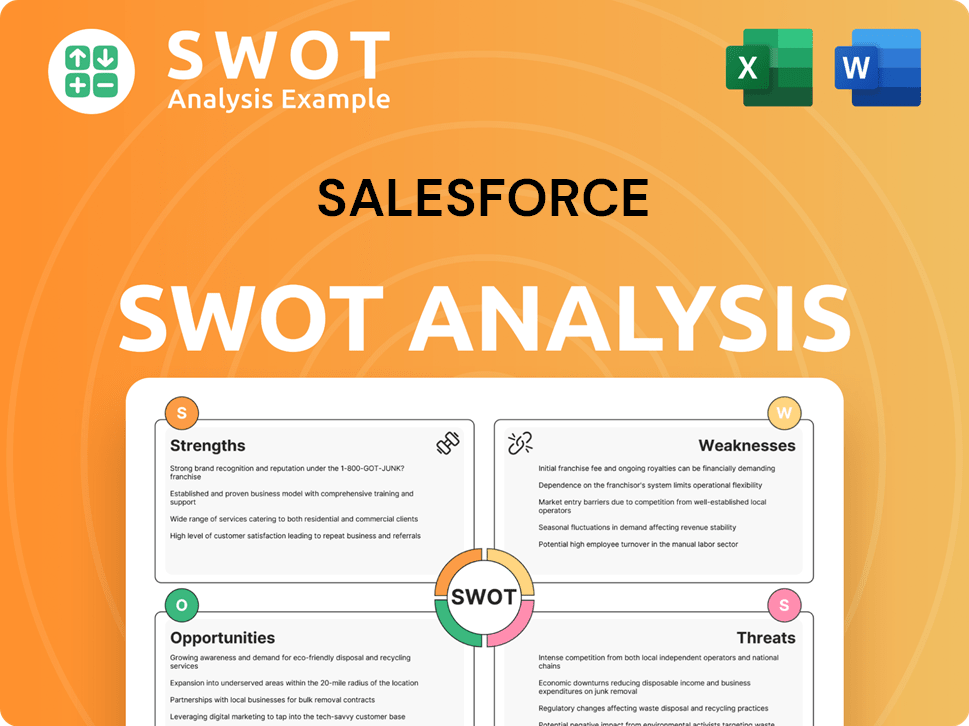
How Does Salesforce Invest in Innovation?
Salesforce’s innovation and technology strategy is a cornerstone of its sustained growth, focusing on cutting-edge technologies like AI, data analytics, and cloud infrastructure. This approach is crucial for maintaining its competitive edge in the CRM software market. The company consistently invests heavily in research and development to stay ahead of industry trends and meet evolving customer needs.
The company's strategy emphasizes leveraging advanced technologies to drive growth. This includes integrating AI-Einstein GPT, Data Cloud for real-time analytics, and Hyperforce for superior cloud infrastructure. These innovations are designed to enhance customer experiences and streamline business processes. Salesforce's commitment to R&D is evident in its significant financial investments in these areas.
Salesforce aims to provide solutions that are both innovative and practical. This includes developing tools that help businesses improve their customer relationship management and achieve their sustainability goals. By focusing on these key areas, Salesforce continues to strengthen its position in the market and drive long-term growth.
Salesforce is making a 'hard pivot' to agentic AI with Agentforce, aiming for AI agents that understand industry contexts. This includes developing multi-agent teams for complex tasks like product launches and marketing campaigns. The Atlas Reasoning Engine employs multiple LLMs and LAMs for trustable autonomy.
Data integration is a key focus, with the Data Cloud designed to eliminate data silos and provide a 360-degree view of customers. Improved integration capabilities with external databases and applications are also being developed. This strategy enhances the company's cloud platform features.
Salesforce is exploring augmented reality (AR) and virtual reality (VR) technologies, with potential commercialization by 2029–2030. These technologies could revolutionize customer engagement and data visualization. These advancements are part of the company's long-term growth potential.
Salesforce is committed to sustainability, offering tools like Net Zero Cloud and Sustainability Cloud. These tools help businesses track and reduce their carbon footprints, aligning with global ESG goals. This commitment is part of its overall Salesforce growth strategy.
Salesforce's R&D investments are substantial, with projected expenses of $5.493 billion for 2025, an increase of 11.96% from 2024. From fiscal 2014 to fiscal 2024, R&D expenses surged by over 700%. This highlights the company's dedication to innovation and development.
Salesforce emphasizes the ethical application of AI through its Einstein Trust Layer. This approach aims to build trust and enhance user acceptance of AI technologies. This is crucial for the long-term success of its artificial intelligence integration.
Salesforce's innovation and technology strategy is designed to drive future revenue projections and maintain its Salesforce market share. The company's focus on AI, data, and cloud computing positions it well in the competitive landscape. For a deeper dive into how Salesforce approaches marketing, check out the Marketing Strategy of Salesforce.
- Continued investment in AI and machine learning to enhance its CRM software.
- Expansion of the Data Cloud to provide more comprehensive data analytics capabilities.
- Development of AR/VR solutions to improve customer engagement.
- Focus on sustainability to meet the growing demand for eco-friendly solutions.
Salesforce PESTLE Analysis
- Covers All 6 PESTLE Categories
- No Research Needed – Save Hours of Work
- Built by Experts, Trusted by Consultants
- Instant Download, Ready to Use
- 100% Editable, Fully Customizable
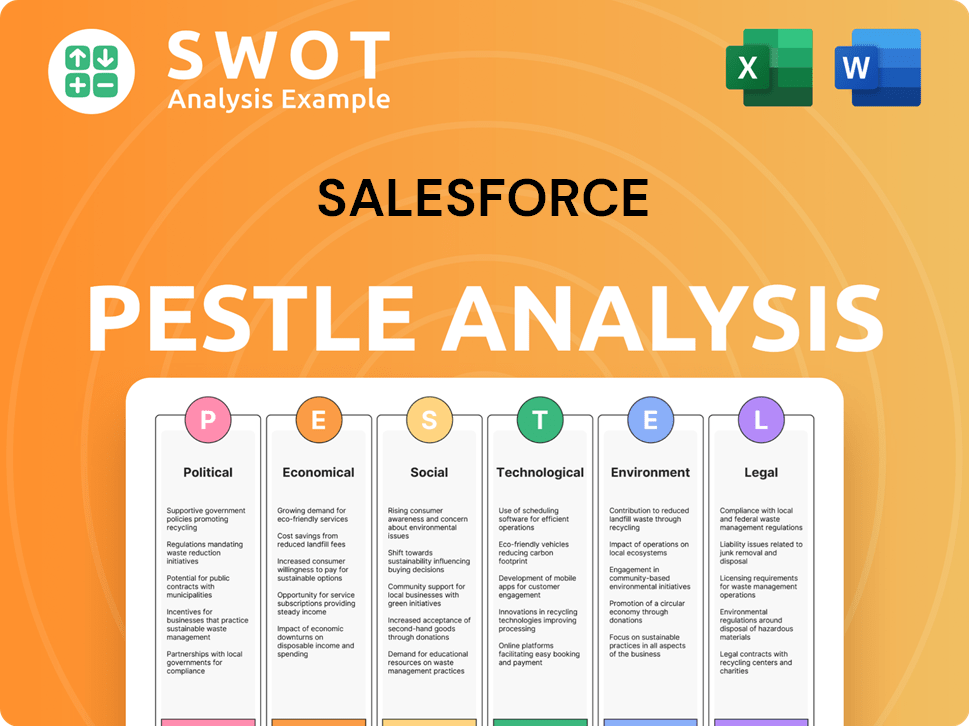
What Is Salesforce’s Growth Forecast?
The financial outlook for the company indicates continued growth, albeit at a slightly moderated pace compared to previous periods. For fiscal year 2025, the company anticipates revenue between $40.5 billion and $40.9 billion, reflecting a year-over-year increase of 7% to 8%. This projection suggests a solid trajectory for the company's financial performance, even as it navigates the dynamic landscape of the cloud computing and CRM software markets.
Subscription and support revenue is expected to grow by approximately 8.5% year-over-year. The company's performance in fiscal year 2024 was strong, with total revenue reaching $37.9 billion, marking a 9% year-over-year increase. Subscription and support revenue specifically reached $35.7 billion, up 10% year-over-year, demonstrating the core strength of its business model. These figures underscore the company's robust position within the industry and its ability to generate consistent revenue streams.
In the first quarter of fiscal year 2025, ending April 30, 2024, the company reported revenue of $9.13 billion, an 11% year-over-year increase. Subscription and Support services contributed $8.59 billion, a 12% year-over-year increase. The GAAP operating margin for Q1 FY25 stood at 18.7%, and the non-GAAP operating margin reached 32.1%. The company's financial health is further evidenced by its strong cash flow performance and strategic capital allocation, which support its long-term growth potential.
The company's financial performance in Q1 FY25 showcased robust growth. Revenue increased by 11% year-over-year, reaching $9.13 billion. Subscription and Support services, a key revenue driver, saw a 12% year-over-year increase, contributing $8.59 billion.
The company's operating margins in Q1 FY25 were strong, with a GAAP operating margin of 18.7% and a non-GAAP operating margin of 32.1%. For the full fiscal year 2025, the company projects a GAAP operating margin of 21.6% and a non-GAAP operating margin of 34.0%.
Operating cash flow in Q1 FY25 was $6.25 billion, a significant 39% increase year-over-year. Free cash flow also increased by 43% to $6.08 billion. The company returned $2.2 billion to shareholders through share repurchases and paid $0.4 billion in dividends.
Data Cloud and AI annual recurring revenue reached $900 million in FY25, up 120% year-over-year. The company closed 5,000 Agentforce deals since October, including over 3,000 paid. This highlights the company's innovation and development in these key areas.
The company's financial strategy includes returning capital to shareholders and investing in growth areas such as Data Cloud and AI. The company's commitment to innovation and strategic partnerships will be key drivers for its future revenue projections and long-term growth potential. The company's focus on customer success, as evidenced by its customer success stories, is critical to maintaining its market share and competitiveness in the CRM software and cloud computing markets. You can learn more about the company's core values by reading Mission, Vision & Core Values of Salesforce.
Salesforce Business Model Canvas
- Complete 9-Block Business Model Canvas
- Effortlessly Communicate Your Business Strategy
- Investor-Ready BMC Format
- 100% Editable and Customizable
- Clear and Structured Layout
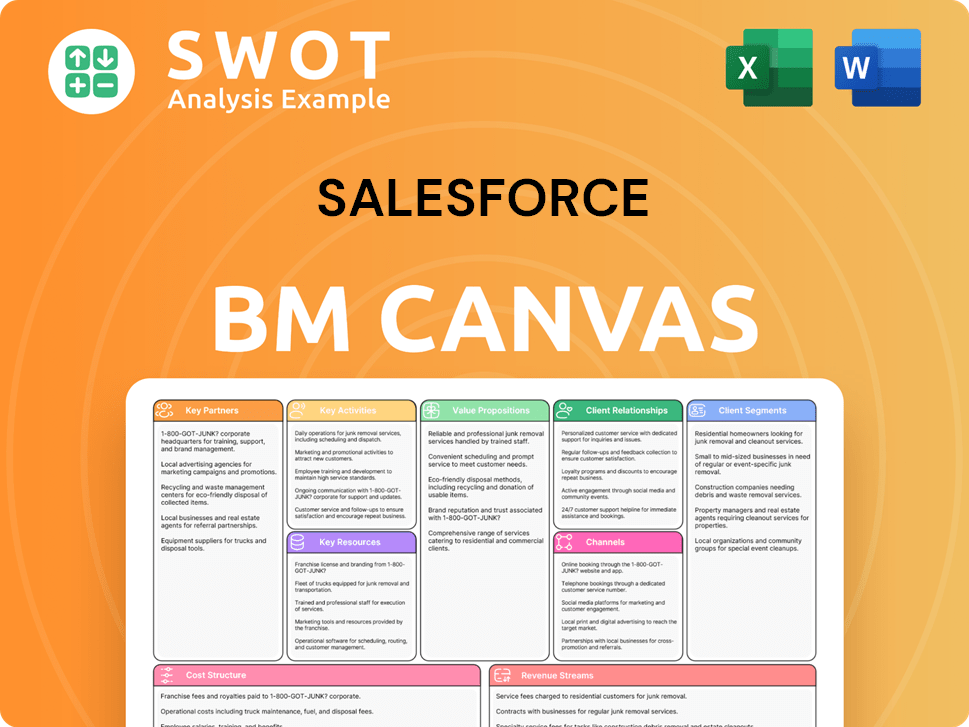
What Risks Could Slow Salesforce’s Growth?
The future of the company, and its growth strategy, faces several challenges. A key concern is the potential slowdown in revenue growth, which could impact its market position. Understanding these risks is crucial for assessing the company's long-term prospects.
Competition in the CRM software and cloud computing markets is intensifying. The company’s ability to innovate and adapt to new technologies, such as AI, will be critical. The rapid pace of technological advancements requires continuous adaptation to maintain its Salesforce market share.
Regulatory changes and operational complexities also pose significant hurdles. The company must navigate evolving data privacy laws and manage the complexities of data migration and user adoption. Addressing these challenges effectively will be essential for sustained growth.
The company's revenue growth is projected to slow down, posing a risk to its expansion plans. The fiscal year 2026 guidance suggests a growth rate of 6-8%, which is lower than the average of 12.7% over the past three years. This slowdown reflects cautious enterprise spending.
The CRM and cloud computing markets are becoming increasingly competitive. Competitors like ServiceNow and tech giants are investing heavily in AI. This increased competition could impact the company’s market share and future revenue projections.
Evolving data privacy regulations, such as GDPR and CCPA, present compliance challenges. The company's AI capabilities, which rely on customer data, make these risks even more relevant. The company actively supports risk-based AI regulation.
Data migration, integration, and user adoption pose significant operational challenges. Over-customization and security vulnerabilities can also impact system stability. Addressing these issues is crucial for maintaining customer trust and system integrity.
The company's 'hard pivot' to AI and the rapid release of new products, including Agentforce, may outpace some companies' ability to adapt. This could affect user adoption if not properly managed. Adapting to new AI technologies is a key aspect of the company's innovation and development.
Delayed security patches, misconfigurations, and lack of access controls heighten data breach risks. Robust security measures, regular audits, and compliance checks are essential. The company addresses these risks through diversification and risk management frameworks.
The company faces competition from other enterprise software providers and tech giants. A detailed analysis of the competitors is available in the Competitors Landscape of Salesforce. Understanding the competitive landscape is crucial for evaluating the company’s market position.
Evolving regulations, such as GDPR and CCPA, require the company to maintain robust data protection measures. The company’s AI initiatives must comply with these regulations. Compliance is essential for maintaining customer trust and avoiding penalties.
Data migration and user adoption present operational challenges. Over-customization and security vulnerabilities can impact system stability and increase costs. Addressing these risks is essential for ensuring customer satisfaction and maintaining system integrity.
Strategic partnerships can mitigate some risks and support expansion into new markets. These partnerships can help the company integrate new technologies and improve customer success. The company’s ability to form effective partnerships is crucial for long-term growth potential.
Salesforce Porter's Five Forces Analysis
- Covers All 5 Competitive Forces in Detail
- Structured for Consultants, Students, and Founders
- 100% Editable in Microsoft Word & Excel
- Instant Digital Download – Use Immediately
- Compatible with Mac & PC – Fully Unlocked
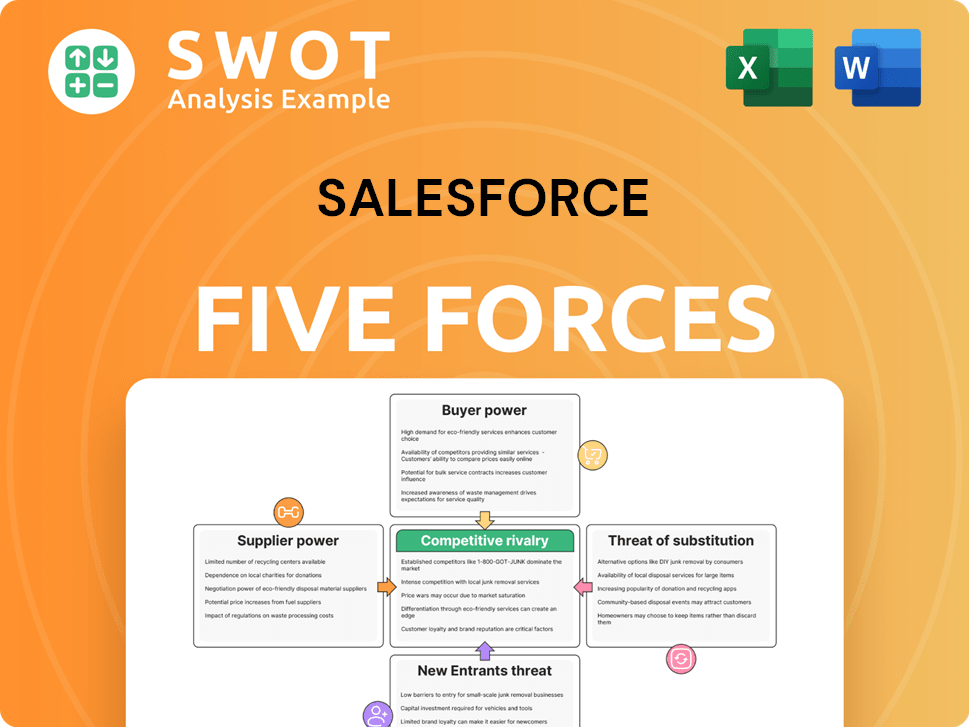
Related Blogs
- What are Mission Vision & Core Values of Salesforce Company?
- What is Competitive Landscape of Salesforce Company?
- How Does Salesforce Company Work?
- What is Sales and Marketing Strategy of Salesforce Company?
- What is Brief History of Salesforce Company?
- Who Owns Salesforce Company?
- What is Customer Demographics and Target Market of Salesforce Company?
Disclaimer
All information, articles, and product details provided on this website are for general informational and educational purposes only. We do not claim any ownership over, nor do we intend to infringe upon, any trademarks, copyrights, logos, brand names, or other intellectual property mentioned or depicted on this site. Such intellectual property remains the property of its respective owners, and any references here are made solely for identification or informational purposes, without implying any affiliation, endorsement, or partnership.
We make no representations or warranties, express or implied, regarding the accuracy, completeness, or suitability of any content or products presented. Nothing on this website should be construed as legal, tax, investment, financial, medical, or other professional advice. In addition, no part of this site—including articles or product references—constitutes a solicitation, recommendation, endorsement, advertisement, or offer to buy or sell any securities, franchises, or other financial instruments, particularly in jurisdictions where such activity would be unlawful.
All content is of a general nature and may not address the specific circumstances of any individual or entity. It is not a substitute for professional advice or services. Any actions you take based on the information provided here are strictly at your own risk. You accept full responsibility for any decisions or outcomes arising from your use of this website and agree to release us from any liability in connection with your use of, or reliance upon, the content or products found herein.